Related Research Articles
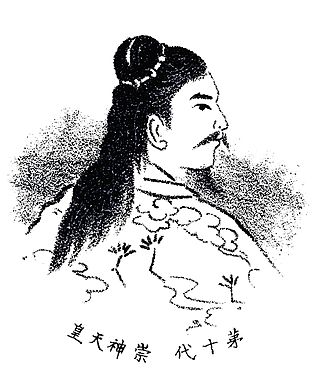
Emperor Sujin, also known as Mimakiirihikoinie no Mikoto (御眞木入日子印恵命) in the Kojiki, and Mimakiiribikoinie no Sumeramikoto (御間城入彦五十瓊殖天皇) or Hatsukunishirasu Sumeramikoto (御肇國天皇) in the Nihon Shoki was the tenth Emperor of Japan. While Sujin is the first emperor whose existence historians widely accept, he is still referred to as a "legendary emperor" due to a lack of information available and because dates for his reign vary. Both the Kojiki, and the Nihon Shoki record events that took place during Sujin's alleged lifetime. This legendary narrative tells how he set up a new shrine outside of the Imperial palace to enshrine Amaterasu. He is also credited with initiating the worship of Ōmononushi, and expanding his empire by sending generals to four regions of Japan in what became known as the legend of Shidō shogun.

Emperor Suinin, also known as Ikumeiribikoisachi no Sumeramikoto (活目入彦五十狭茅天皇) was the 11th legendary Emperor of Japan, according to the traditional order of succession. Less is known about Suinin than his father, and likewise he is also considered to be a "legendary emperor". Both the Kojiki, and the Nihon Shoki record events that took place during Suinin's alleged lifetime. This legendary narrative tells how he ordered his daughter Yamatohime-no-mikoto to establish a new permanent shrine for Amaterasu, which eventually became known as the Ise Grand Shrine. Other events that were recorded concurrently with his reign include the origins of Sumo wrestling in the form of a wrestling match involving Nomi no Sukune.
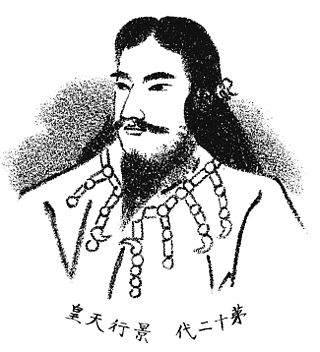
Emperor Keikō, also known as Ootarashihikooshirowake no Sumeramikoto (大足彦忍代別天皇) and Ōtarashihiko-oshirowake no Mikoto (大帯日子淤斯呂和氣天皇), was the 12th legendary Emperor of Japan, according to the traditional order of succession. Both the Kojiki, and the Nihon Shoki record events that took place during Keikō's alleged lifetime. Keikō was recorded as being an exceptionally tall emperor who had a very large family. During his reign he sought to expand territorial control through conquest of local tribes. He had a very important son named "Prince Ōsu", who was in possession of the Kusanagi when he died. This treasure was later moved to Atsuta Shrine, and is now a part of the Imperial Regalia of Japan. There is a possibility that Keikō actually lived or reigned in the 4th century AD rather than the 1st, but more information is needed to confirm this view.

Emperor Kōmei was the 121st Emperor of Japan, according to the traditional order of succession. Kōmei's reign spanned the years from 1846 through 1867, corresponding to the final years of the Edo period.
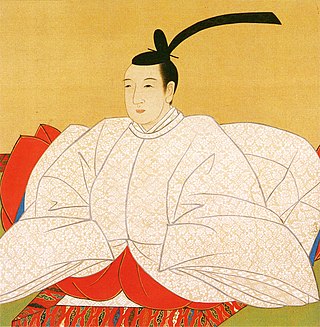
Emperor Ninkō was the 120th Emperor of Japan, according to the traditional order of succession. Ninkō's reign spanned the years from 1817 until his death in 1846, and saw further deterioration of the power of the ruling Shōgun. Disasters, which included famine, combined with corruption and increasing Western interference, helped to erode public trust in the bakufu government. Emperor Ninkō attempted to revive certain court rituals and practices upon the wishes of his father. However, it is unknown what role, if any, the Emperor had in the turmoil which occurred during his reign. His family included fifteen children from various concubines, but only three of them lived to adulthood. His fourth son, Imperial Prince Osahito became the next Emperor upon Ninkō's death in 1846. While political power at the time still resided with the Shōgun, the beginnings of the Bakumatsu were at hand.

Emperor Sakuramachi was the 115th Emperor of Japan, according to the traditional order of succession. Sakuramachi's birth name was Teruhito before he became enthroned as Emperor in 1735, a reign that would last until 1747 with his retirement. As with previous Emperors during the Edo period, the Tokugawa shogunate had control over Japan. The Emperor's role was a religious figure who performed limited duties. This changed when Sakuramachi was granted permission from the Shōgun to restore some Imperial rites. Ceremonies such as the Harvest Festival that had previously been absent for over 250 years were now allowed. Sakuramachi had one wife and a concubine with whom he fathered 4 children. His first son would go on to become Emperor Momozono, while his second daughter would later be Empress Go-Sakuramachi. Sakuramachi died on 28 May 1750, which was almost three years after his abdication.
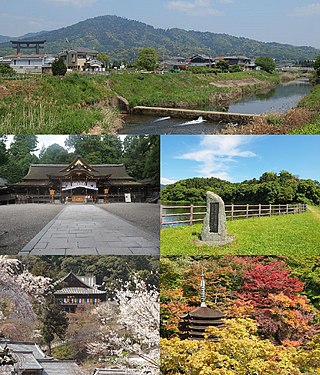
Sakurai is a city located in Nara Prefecture, Japan. As of March 31, 2017, the city has an estimated population of 58,386, and 24,629 households. The population density is 590 inhabitants per square kilometre (1,500/sq mi), and the total area is 98.92 square kilometres (38.19 sq mi).
The current capital of Japan is Tokyo. In the course of history, the national capital has been in many locations other than Tokyo.

Isonokami Shrine is a Shinto shrine located in the hills of Furu in Tenri, Nara prefecture, Japan. It is one of the oldest extant Shinto shrines in Japan and has housed several significant artifacts.

Chōroku (長禄) was a Japanese era name after Kōshō and before Kanshō. This period spanned the years from September 1457 through December 1460. The reigning emperor was Go-Hanazono-tennō (後花園天皇).

An Asama shrine is a type of Shinto Shrine in Japan centered on the worship of the kami of volcanos in general, and Mount Fuji in particular.

The Fujisan Hongū Sengen Taisha (富士山本宮浅間大社) is a Shintō shrine in the city of Fujinomiya in Shizuoka Prefecture, Japan. It is the ichinomiya of former Suruga Province, and is the head shrine of the approximately 1300 Asama or Sengen shrines in the country. The shrine has an extensive location within downtown Fujinomiya; in addition, the entire top of Mount Fuji from the 8th stage upwards is considered to be part of the shrine grounds.
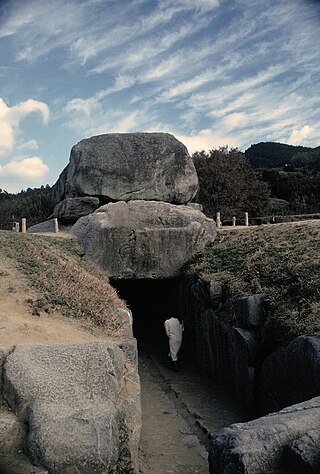
Asuka (飛鳥) was the Imperial capital of Japan during the Asuka period, which takes its name from this place. It is located in the present-day village of Asuka, Nara Prefecture.
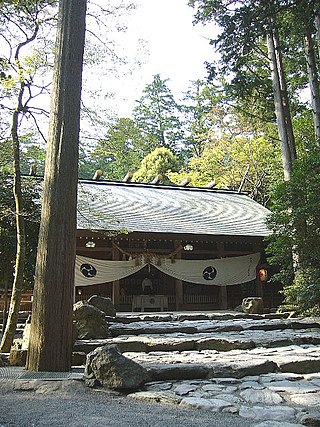
Tsubaki Grand Shrine is a Shinto shrine in the Yamamoto neighborhood of the city of Suzuka in Mie Prefecture, Japan. It is one of the two shrines which claim the title of ichinomiya of former Ise Province. The main festival of the shrine is held annually on October 11.

Richard Arthur Brabazon Ponsonby-Fane was a British academic, author, specialist of Shinto and Japanologist.

Izushi Jinja (出石神社) is a Shinto shrine in the Izushi neighborhood of the city of Toyooka in Hyōgo Prefecture, Japan. It is the ichinomiya of former Tajima Province. The main festival of the shrine is held annually on October 20.

Masumida Shrine is a Shinto shrine in the Masumida neighborhood of the city of Ichinomiya in Aichi Prefecture, Japan. It is the ichinomiya of former Owari Province. The main festival of the shrine is held annually on April 3.
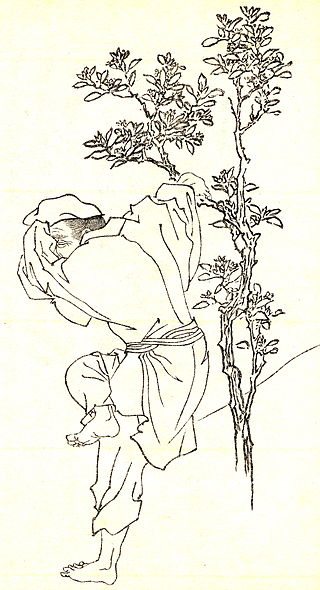
Tajimamori is a Japanese legendary figure of the Kofun period, also worshipped as the god of sweets. His name is written in kanji as 多遅麻毛理 in the Kojiki, and as 田道間守 in the Nihon Shoki.
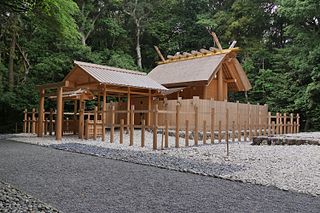
Izawa-no-miya (伊雑宮) is a Shinto shrine in the Kaminogō neighborhood of Isobe in the city of Shima in Mie Prefecture, Japan. It is one of the two shrines claiming the title of ichinomiya of former Shima Province. Together with the Takihara-no-miya (瀧原宮) in Taiki, it is one of the Amaterasu-Ōkami no Tonomiya (天照大神の遙宮), or external branches of the Inner Shrine of the Ise Grand Shrine.
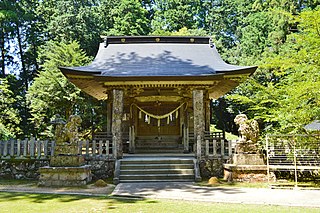
Awaga Jinja (粟鹿神社) is a Shinto shrine in the Santocho Awaga neighborhood of the city of Asago in Hyōgo Prefecture, Japan. It is one of the two shrines which claim the title of ichinomiya of former Tajima Province. The main festival of the shrine is held annually on October 17.
References
- 1 2 Ponsonby-Fane, Richard (1959). The Imperial House of Japan. Ponsonby Memorial Society. p. 32.